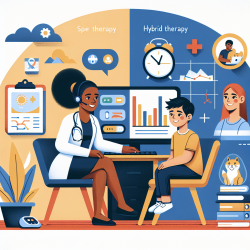The recent study "Comparisons of Clients and Caregivers Satisfaction Across Conventional, Virtual, and Hybrid Speech-Language Therapy Services in Malaysia" provides invaluable insights for speech-language pathologists (SLPs) aiming to enhance their service delivery methods. Conducted by Hassan et al., the study compares client and caregiver satisfaction across three modes of speech-language therapy: conventional face-to-face (C-SLT), speech-language teletherapy (SLTT), and hybrid speech-language therapy (H-SLT).
Here are the key findings and actionable steps for practitioners:
Key Findings
- Overall Satisfaction: The study found no significant differences in overall satisfaction among the three service delivery modes (C-SLT, H-SLT, and SLTT). This indicates that clients and caregivers are equally satisfied regardless of the method used.
- Income Influence: Income was the only sociodemographic factor that significantly influenced satisfaction levels in teletherapy. Participants from lower-income categories showed higher satisfaction with SLTT.
- Teletherapy Benefits: High satisfaction in teletherapy was attributed to convenience factors such as reduced travel time and costs, and the ability to receive therapy in a familiar environment.
- Challenges in Teletherapy: Some persistent challenges include technological issues and the lack of physical presence, which can hinder effective communication, especially for younger clients or those with cognitive disabilities.
Actionable Steps for Practitioners
- Implement Hybrid Models: Consider incorporating hybrid models that combine face-to-face and teletherapy sessions. This approach leverages the strengths of both methods while minimizing their limitations.
- Focus on Convenience: Emphasize the convenience factors of teletherapy in your practice. Highlight the reduced travel time and costs to clients and caregivers.
- Address Technological Barriers: Ensure that your teletherapy platform is user-friendly and provide troubleshooting support. This can significantly improve the user experience and satisfaction levels.
- Tailor Services Based on Income Levels: Be mindful of the income levels of your clients. Those from lower-income backgrounds may benefit more from teletherapy services, which can be more cost-effective.
For further details and a comprehensive understanding of the study, you can read the original research paper by following this link: Comparisons of Clients and Caregivers Satisfaction Across Conventional, Virtual, and Hybrid Speech-Language Therapy Services in Malaysia.
By integrating these findings into your practice, you can make data-driven decisions that enhance the quality of care and satisfaction for your clients and their caregivers.










